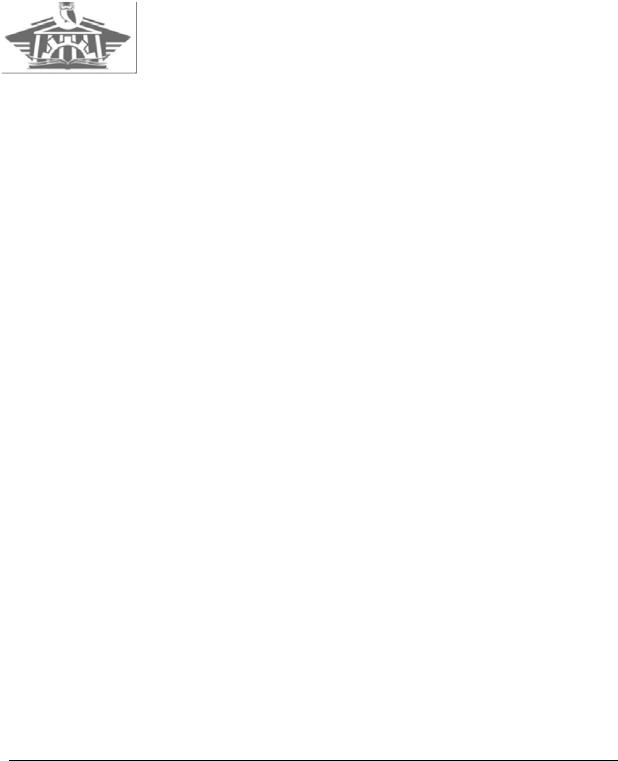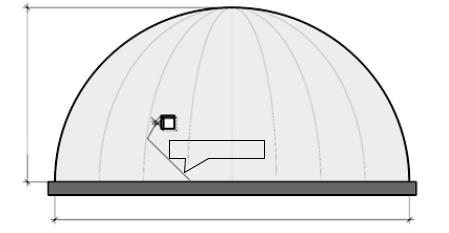
Russian Journal of Building Construction and Architecture
.pdfRUSSIAN JOURNAL
OF BUILDING
CONSTRUCTION AND ARCHITECTURE

The journal is indexed/abstracted in:
Web of Science Core Collection
(Emerging Sources Citation Index)
(Thomson Reuters), USA
Ulrich's Periodicals Directory
(Bowker), USA
DOAJ
(Lund University), Sweden
Academic Search Complete
(EBSCO), USA
SOCOLAR
(China Educational Publications Import
and Export Corporation –– CEPIEC),
China
Google Scholar
(Google), USA
E-Library
(ООО «РУНЭБ»), Russia
J-Gate
(Informatics Ltd), India
ISSN 2542-0526
RUSSIAN JOURNAL
OF BUILDING CONSTRUCTION
AND ARCHITECTURE
N 1 (49)
BUILDING STRUCTURES, BUILDINGS AND CONSTRUCTIONS
BASES AND FOUNDATIONS, UNDERGROUND STRUCTURES
HEAT AND GAS SUPPLY, VENTILATION, AIR CONDITIONING, GAS SUPPLY AND ILLUMINATION
BUILDING MATERIALS AND PRODUCTS
TECHNOLOGY AND ORGANIZATION OF CONSTRUCTION
DESIGNING AND CONSTRUCTION OF ROADS, SUBWAYS, AIRFIELDS, BRIDGES AND TRANSPORT TUNNELS
BUILDING MECHANICS
THEORY AND HISTORY OF ARCHITECTURE, RESTORATION AND RECONSTRUCTION OF HISTORICAL
AND ARCHITECTURAL HERITAGE
ARCHITECTURE OF BUILDINGS AND STRUCTURES. CREATIVE CONCEPTIONS OF ARCHITECTURAL ACTIVITY
CITY PLANNING, PLANNING OF VILLAGE SETTLEMENTS
Voronezh 2021

Russian Journal
of Building Construction and Architecture
Periodical scientific edition
Published since 2009 |
Comes out 4 times per annum |
|
|
|
|
Founder and publisher: Voronezh State Technical University.
The territory of distribution — Russian Federation.
The articles are reviewed and processed with the program ANTIPLAGIARISM. This publication cannot be reprinted without the prior permission of the publisher, references are obligatory.
Previous name: «Scientific Herald of the Voronezh State University of Architecture and Civil Engineering. Construction and Architecture».
EDITORIAL BOARD
Editor-in-Chief: Melkumov V. N., D. Sc. in Engineering, Prof.,
Voronezh State Technical University
Boldyrev А.М., Corresponding Member of the Russian Academy of Architecture and Engineering Science, D.Sc. in Engineering, Prof., Voronezh State Technical University, Russia
Bondarev B. А., D. Sc. in Engineering, Prof., Lipetsk State Technical University, Russia
Gagarin V. G., Corresponding Member of RAABS, Moscow State University of Civil Engineering, Russia
Gelfond А. L., Corresponding Member of the Russian Academy of Architecture and Construction Science, D. Sc. in Architecture, Nizhniy Novgorod State University of Architecture and Construction, Russia
Enin A. Ye., PhD in Architecture, Prof., Voronezh State Technical University, Russia
Karpenko N. I., Academician of RAABS, Research Institute of Building Physics (NIISF RAABS), Russia
Kirsanov М.N., D.Sc. in Physics and Mathematics, Professor (National Research University “Moscow Power Engineering Institute”)
Kolchunov V. I., Academician of RAABS, Southwest State University, Kursk, Russia
Ledenyev V. I., D. Sc. in Engineering, Prof., Tambov State Technical University, Russia
Lyahovich L. S., Academician of RAABS, Tomsk State University of Architecture and Building, Russia
Mailyan L. R., D. Sc. in Engineering, Prof., Don State Technical University, Rostov, Russia
Osipova N.N., D. Sc. in Engineering, Yury Gagarin Saratov State Technical University, Russia
Panibratov Yu. P., Academician of RAABS, Saint Petersburg State University of Architecture and Civil Engineering, Russia Podolsky Vl.P., D. Sc. in Engineering, Prof., Voronezh State Technical University, Russia (Dep. of the Editor-in-Chief)
Suleymanov А.М., D. Sc. in Engineering, Prof., Kazan State University of Architecture and Engineering, Russia
Fyedorov V. S., Academician of RAABS, Moscow State University of Railway Engineering, Russia
Fedosov S. V., Academician of RAABS, Moscow State University of Civil Engineering, Russia
Chernyshov Ye. M., Academician of RAABS, Voronezh State Technical University, Russia
Shubenkov М. V., Academician of the Russian Academy of Architecture and Construction Science, D. Sc. in Architecture, Prof., Моscow Institute of Architecture (State Academy), Russia Asanowicz Alexander, Prof., Dr. of Sn., Technical University of Bialystok, Poland
Figovsky Oleg L., Prof., Dr. of Sn., Member of EAS, Israel Korsun V. I., D. Sc. in Engineering, Prof., The Donbas National Academy of Civil Engineering and Architecture, Ukraine
Nguyen Van Thinh, Prof., Dr. of Sn., Hanoi University of Architecture, Vietnam
Editor: Kotlyarova E. S. Translator: Litvinova O. A. Executive secretary: Aralov E. S.
Publication date 20.02.2020. Format 60×84 1/8. Conventional printed sheets 9,3. Circulation 500 copies. Order 34. Number of the certificate of registration of the media ПИ № ФС 77-67855
Issued by the Federal Service for Supervision of Communications, Information Technology, and Mass Media (Roskomnadzor)
Price is subject to change
THE ADDRESS of EDITORIAL AND THE PUBLISHER OFFICE:
room2230,84 20-letiya Oktyabrya str., Voronezh, 394006, Russian Federation Tel./fax: (473)2-774-006; e-mail: vestnik_vgasu@mail.ru
Published in Printing Office of Voronezh State Technical University 84 20-letiya Oktyabrya str., Voronezh, 394006, Russian Federation
© Voronezh State Technical University, 2021
Issue № 1 (49), 2021 |
ISSN 2542-0526 |
|
|
|
|
CONTENTS |
|
BUILDING STRUCTURES,BUILDINGS AND CONSTRUCTIONS ................................................... |
6 |
Gridnev S. Yu., Sotnikova O. A., Prokshits E. E. |
|
Numerical Studies of the Influence of the Parameters of Thin-Shell Dome Structure |
|
on Their Optimization From the Position of Spatial Stability ................................................... |
6 |
Kuznetsov D. N., Grigorash V. V., Svetnikov А. А. |
|
Work Power of the Support Unit of the Steel I-Beam............................................................. |
19 |
Mailyan L. R., Stel'makh S. A., Shcherban E. M., Nazhuev M. P. |
|
Setting a Diagram Approach to Calculating Vibrated, Centrifuged and Vibrocentrifuged |
|
Reinforced Concrete Columns with a Variatropic Structure ................................................... |
30 |
HEAT AND GAS SUPPLY,VENTILATION,AIR CONDITIONING, |
|
GAS SUPPLY AND ILLUMINATION............................................................................................ |
45 |
Kushchev L. A., Melkumov V. N., Savvin N. Yu. |
|
Computer Simulation of Flow in Corrugated Channel of Plate Heat Exchanger.................... |
45 |
Shuraits A. L., Birykov A. V., Usachev А. Р. |
|
Development of a Calculation Method for Two-Stage Natural Gas Purification |
|
Plants From Mechanical Impurities......................................................................................... |
54 |
DESIGNING AND CONSTRUCTION OF ROADS,SUBWAYS,AIRFIELDS,BRIDGES |
|
AND TRANSPORT TUNNELS ..................................................................................................... |
66 |
Ryabova O. V., Skrypnikov A. V., Kozlov V. G., Tikhomirov P. V. |
|
Studying a Geographical Environment for Road Design............................................................. |
66 |
INSTRUCTIONS TO AUTHORS................................................................................................... |
79 |
5

Russian Journal of Building Construction and Architecture
BUILDING STRUCTURES,BUILDINGS AND CONSTRUCTIONS
DOI 10.36622/VSTU.2021.49.1.001 UDC 624.01
S. Yu. Gridnev 1, O. A. Sotnikova 2, E. E. Prokshits 3
NUMERICAL STUDIES OF THE INFLUENCE OF THE PARAMETERS OF THIN-SHELL DOME STRUCTURE ON THEIR OPTIMIZATION FROM THE POSITION OF SPATIAL STABILITY
Voronezh State Technical University 1, 2, 3
Russia, Voronezh
1 D. Sc. in Engineering, Prof. of the Dept. of Structural Mechanics, tel.: +7(910)346-60-19, e-mail: gridnev_s_y@rambler.ru
2 D. Sc. in Engineering, Prof. of the Dept. of Design of Buildings and Structures Named after N. V. Troitsky, tel.: +7(910)244-55-99, e-mail: hundred@vgasu.vrn.ru
3 Senior lecturer of the Dept. of Design of Buildings and Structures Named after N. V. Troitsky, tel.: +7(919)238-78-74, e-mail: e.prokshits@mail.ru
Statement of the problem. The task was to evaluate the influence of the parameters of thin-walled dome coatings using the capabilities of modern software complexes. The method of optimization of dome covering structures with selection of criteria and parameters of the task has been improved.
Results. The article presents the results of refinement and testing of the methodology for addressing the problem of optimizing dome structures with the choice of criteria and parameters of the optimization problem using the capabilities of the Topological Optimization module of the finiteelement computational complex MidasCivil. The objective function was considered dependent on the thickness of the dome, the modulus of elasticity of the Poisson coefficient of the material. The study employs the positions of the theory of elasticity, solid body deformation mechanics, construction mechanics, as well as mathematical modeling methods based on the use of the finite element method employing modern licensed finite-element computing complexes MidasCivil and the Ing + architectural and construction design system of the calculation module MicroFe.
Conclusions. Using the methods of optimal (in particular, geometric) design, the most affecting parameters of thin-walled dome coatings and their combinations were identified. This will allow us to design the most rational, economical and architectural-expressive dome structures as well as to make sound design decisions.
Keywords: dome coverings, finite element model, topological optimization, spatial stability, design optimizations, criteria and parameters of optimization problem.
Introduction. The use of domed structures has of late been gaining momentum due to the massive construction and restoration of religious buildings. The design and construction of temple structures has been an essential element of modern design and architecture over the
© Gridnev S. Yu., Sotnikova O. A., Prokshits E. E., 2021
6
Issue № 1 (49), 2021 |
ISSN 2542-0526 |
last 25 years. Since the early 1990s, the active construction of religious buildings of various denominations got underway. If religious architecture is to be compared with other secular types of architectural structures, it can be noted that purely architectural forms rather than economic, financial or technological considerations dominate [13].
Thus the feasibility of conducting theoretical and applied research in the field of optimizing the shape and structure of dome structures increases. Therefore in the recent years, a numerical method for calculating various structures, FEM, i.e., the finite element method, has become common. It has a range of advantages compared to other numerical methods, such as the finite difference method, etc. This is diversity in regard to design schemes, clarity of the design scheme, easy algorithmization, the capacity to automate the calculation process and to implement any boundary conditions [1, 7].
A number of studies by both Russian [2––6, 8––12] and overseas scientists [16––17, 19––21] are dedicated to the study of SSS as well as the optimization of different types of structures. Unfortunately, not enough attention has been paid to optimizing reinforced concrete dome surfacing. In [18], the major provisions of the methodology for addressing the problem of optimizing structures of dome surfacing of a circular shape under operational loads in the structure from the viewpoint of preventing possible forms of buckling were developed and some results of numerical investigations were presented. It is obvious that the development and improvement of the methods for the optimal design of building structures as well as the use of modern specialized software systems make it simple to design rational and economical structures of a dome shape and are a relevant research area.
The objective of the study is to clarify, conduct full-scale research and test the methodology previously set forth by the authors for the optimal design of thin-walled reinforced concrete dome structures to obtain one where a decrease in material consumption could be achieved with constant values of the existing and increasing load-bearing capacities. Applying mathematical modeling methods based on the use of the finite element method in combination with modern licensed finite element computing systems MidasCivil and systems of end-to-end architectural and construction design Ing + calculation module MicroFe employing the results of numerical studies, it is essential to analyze the influence of different parameters and their combinations on optimization thin-walled dome surfacing.
1. Technique for optimizing the parameters of the dome surfacing. The objective of the research is a round reinforced concrete thin-walled dome surfacing of the main hall of the complex of the iconic building of the Annunciation Cathedral in Voronezh. This object was
7

Russian Journal of Building Construction and Architecture
selected as an example for optimizing the dome structure in order to obtain its version employing a smaller amount of material, which can be subsequently used in the design and construction of religious and spectacular structures in the regions, both in normal and in special construction conditions, such as heavy snow load with low temperature indicators or high humidity and temperature indicators.
In order to design a computational model, a shell hybrid finite element and a shell finite element is employed based on the displacement method taken from the FE library of the MicroFe design module. In this case, the following provisions were used:
1.The dome surfacing was modeled by elements of a flat shell taking into account shear deformations along the shell thickness based on the Reissner-Mindlin theory.
2.Geometric nonlinearity in the calculation is not considered due to small displacements of the structure.
Physical nonlinearity is not considered in the calculation as the entire surfacing is compressed; the effect of opening cracks, plastic deformations in concrete and reinforcement, redistribution of forces between the elements is not observed.
In order to choose the type of finite element for further use, preliminary numerical studies of the stress-strain of a reinforced concrete smooth dome surfacing with a diameter of 16 m and a shell thickness of 6 cm with a monolithic reinforced concrete ring with a cross-sectional area of 60×60 cm were conducted. In this case, the FE method of displacement and hybrid FE were used. The calculation was performed for a combination of loads: own weight and snow load of the dome surfacing with a monolithic support ring.
The analysis of the results enables us to conclude that their discrepancy is small. In the future, when performing calculations, hybrid FE will be used.
A reinforced concrete dome is optimized, which is a circle with a diameter of 16 m with an initial constant thickness of 0.06 m, pinched in a support ring or pivotally supported on a support ring made of brick with a constant cross section [18]. A diagram of the dome in question with the major geometric characteristics is shown in Fig. 1.
The greatest development for actually designed structures was obtained by problems where weight or volume is taken as an optimality criterion, subject to the conditions of strength, rigidity and stability as well as various design constraints. In this case, the optimization problem is reduced to the determination of the vector of design parameters (optimization) [18]. The optimization problem is reduced to the assignment of minimum (or maximum) constraints of the criterion using which the structure can be evaluated. This criterion depends on
8

Issue № 1 (49), 2021 |
ISSN 2542-0526 |
the chosen parameters xi and is called the objective function. In our case, there are several objective functions, so the optimization problem is multi-criteria.
fi x1,x2,...,xn, min. |
(1) |
Camber of arch, f = 8 m
Thickness t = 6 sm
Diameter D = 16 m
Fig. 1. Scheme of the investigated dome with the major geometric characteristics
In this case, the optimization problem is reduced to the determination of the vector of design parameters (optimization). While forming the objective function, optimization parameters were identified and constraints were assigned to optimize the dome surfacing x zi x1,x2,...,xN ,corresponding to the minimum, e.g., the volume of the structure taken
as the objective function: |
|
V x min im1 Ai xi , |
(2) |
according to the restrictions: |
|
–– for strength: |
|
эквmax , |
(3) |
–– for rigidity: |
|
ymax y , |
(4) |
–– by the Euler stability of compressed elements: |
|
i k , i 1,..., p , |
(5) |
–– by own frequencies: |
|
, |
(6) |
9

Russian Journal of Building Construction and Architecture
–– by the limits of change of design variables: |
|
x zi h0, i 1,...,n , |
(7) |
where Ai is the length of a one-dimensional or plan area of a two-dimensional element; xi is the area of cross-sections of one-dimensional or thickness of two-dimensional elements;
эквmax is the value of the equivalent voltage; is the maximum permissible value of the intensity of tensile and compressive stresses (design resistance); y is the maximum allowable deflection of the structure; k is critical stress of buckling of rod elements; is specified frequency of natural vibrations; h0 is the minimum allowable cross-sectional area of a onedimensional element or thickness of a two-dimensional element.
Let us pose the problem of optimizing the dome cover, which consists in minimizing the function of the function. The dawn criterion is the weight of the dome surfacing. In the current study, the objective function will be considered dependent on the following parameters:
––variable thickness of the dome;
––modulus of elasticity;
––Poisson’s ratio;
––camber of arch.
The constants are the dimensions of the support ring. The material of the dome surfacing is reinforced concrete: E = 3.25 104 MPa, μ = 0.2. The dome load is own load 0.55 T/m2 + payload 0.15 T/m2 + snow load at +117 m (wind load not considered).
In compliance with the task, the following constraints are assigned to optimize the dome surfacing:
–– by the strength:
эквmax , |
(8) |
by the vertical displacement of the upper point of the canopy упред, the anticipation at which the loss of stability of the canopy takes place:
|
|
, |
(9) |
ymax yпред |
|||
–– the camber of arch is assigned to the limits of changing the design variables based on the condition:
1 |
|
1 |
|
(10) |
|
f |
6 |
8 |
D. |
||
|
|
|
|
||
10
